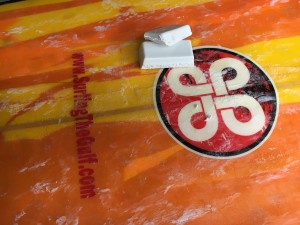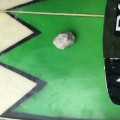Surf wax is sort of a necessity. You need surf wax for almost all surfboards. What many people fail to recognize is, surf wax doesn’t need to be “bumpy.” It doesn’t need to be coated on so thick that there are big clumps on your board. In an effort to try to understand what’s actually an effective amount of surf wax, I’m challenging myself to surf the entire summer using just one bar of surf wax. One bar of surf wax should be more than enough for the entire summer, even with an active summer, surfing every single tropical swell.
I recently spoke to Reily at Honeymoon Island before going out into the lineup. I noticed that he’s one of those surfers who ritualistically coats his surfboard with surf wax, ensuring there are mounds of surf wax on it. I told him, “You’re using too much!” He said, “Oh, I just feel like I’m slipping off, and I need more wax.” The surfboard in question is very long and very thick, and coated with layers of heavy fiberglass. It will be a real challenge to swing around. Your hip movements will want to move faster than the board will let you turn. These quick movement will cause him to slip off his board no matter how much surf wax he’s got on his board, which leads him to believe there isn’t enough on there.

This summer, in an attempt to limit my surf wax usage, I’m taking one bar of surf wax, and only using it as much as is absolutely necessary. The goal is to use only one bar of surf wax or less over the entire summer. The link to this page will be put on the homepage of www.SurfingtheGulf.com, and will be updated throughout the summer with the progress. Follow along as the summer progresses. The link will have the date of most recent update on it.
May 30th, 2018:
As a starting point, the water is just about 80 degrees nearing mid to late Spring. Tropical Storm Alberto just passed us by leaving fun surf in its wake. Before Alberto, I cleared two surfboards of old surf wax, and put a starting coat on top, which left me with a large amount of surf wax for the rest of the summer.
June 23, 2018:
There’s been two swells between the last video and this video. There’s been a tropical storm and a cold front between that first waxing and the one today. In total there were six days worth of surf, three for Alberto and three for the June cold front. Today there was just enough wind to put a small wave on the beach. Before making the trip down to the beach I took a moment to re-wax my longboard surfboard in the areas where the wax had rubbed off. The main area on the board that needed waxing was just behind the center of the board where I lay on the board, and the places where I put my feet while riding the surfboard. I didn’t need to put wax anywhere else. It took about two minutes to put a solid layer of surf wax over the bare spots. After today there should still be a solid amount of wax that should last into the next swell, and of the bar of wax, there’s still more than half left.
For best resolution view on desktop/laptop.
July 30, 2018:
This update covers a little more than the month of July. There were two major surf events on the gulf from the last update. There was a quick blast of swell in late June for just a day. It was really a surprise considering no-one was anticipating the surf coming up. In July a cold front low that sucked up a bunch of tropical moisture generated surf for days. In addition to the 5 or more days of surf, the low had two really solid sized days of unusually larger surf. Surf in the summer isn’t usually big unless there’s a big hurricane spinning around. That unusual couple days got me to pull out the short-board and rip a few gnarly turns. In order for me to use this smaller thinner board that’s really more of a winter board, I needed to remove the cold water wax and put some warm water wax on it. This waxing has brought my wax supply to dangerously low levels (see image below). While I didn’t really need to use this board, and while I could have surfed the red board with the convex bottom, it’s a significant challenge to surf the red board well in bigger surf. Now that I’ve surfed the real short-board I’m reminded of how much better it feels to be able to carve through the water with complete precision. During this event I pulled double sessions, surfing for somewhere close to 6 hours each day. In total this update includes wax usage from a total of 6 days with two extra long days.
June Front
A surprise swell at the end of June.
Cold Front Low
Day 1
Day 2
Day 3
Day 4 Part 1, Part 2
Day 5
